Benefits of Investing in a Great UV Water Purifier System
We are extremely fortunate to have a clean water supply and top-notch treatment facilities in the United States, as anyone who has visited a developing nation can attest.
However, there are still a lot of ailments that are transferred by contaminated water. According to the CDC, 7.2 million Americans fall ill with infections that are transmitted through water each year.
Every homeowner wants access to pure water that is devoid of viruses, germs, cysts, and other microorganisms. UV destroys the water’s bacteria as opposed to other technologies that filter out these contaminants.
You run a substantially higher chance of having contaminated water if you have a well. Fortunately, UV water purifiers can shield you from dangerous germs. But which ones are worthwhile investing in?
Our buyer’s guide will provide you with all the details you need to make an informed choice after we’ve studied the best UV purifiers available and evaluated them based on their key features to determine which UV Water Purifier performs the best for you..
Best UV Water Purifier Systems
Springwell Blackcomb UV Water Filter System
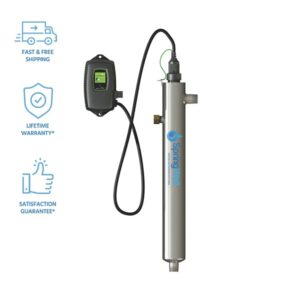
The BLACKCOMB 5.1 by Springwell & LUMINOR is our top selection for the best UV water purifier.
A potent pathogen disinfection that can be connected to a typical whole-house filtration system is the Blackcomb 5.1 UV purifier by Springwell. 99.9% of bacteria, viruses, and diseases, including Cryptosporidium and Giardia, may be killed by the 30mj/cm2 dose.
The “future-proof” expandability port in the splash-proof housing is what distinguishes the Blackcomb 5.1 from other UV purifiers and allows for future upgrades and possibilities. A colourful user interface includes QR codes to access information and videos on the internet and makes it simple to see how much lamp life is left as well as any errors or faults.
Due to its unique design and several benefits, including a modern controller, LCD display, water quality indicator, and the flexibility to upgrade or change the system with built-in ports, this system takes the top rank.
It is possible to use this UV filter alone or in conjunction with a whole-house water filter because it is made for whole-house use. One of the best UV filters available, this unit has a high 15 GPM water flow and 30mj/cm2 UV purification power.
If you buy the system without a separate water filter, Springwell advises adding a sediment filter before UV rays are exposed to the water.
Pros
- Powerful 30mj/cm2 performance
- Kills 99.9% bacteria
- Low-profile design
- Advanced controller in a splash-proof housing
- Real-time feedback on the effectiveness of the purifier and the quality of the water is provided through an LCD colour monitor.
- Countdown to filter change
Cons
- Sediment pre-filter charged separately.
- Additional components are required for installation
Viqua D4 Premium
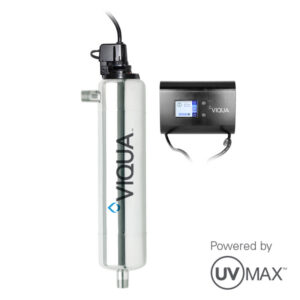
The Viqua D4 Premium is a whole-house UV water treatment system that is best suited for residential homes with well water because it primarily removes bacteria from water. This UV filter provides quick, effective water treatment without affecting the water pressure in your shower or other water-based appliances, with a flow rate of up to 12 GPM.
Without the use of chemicals, the Viqua D4 is a whole-house UV treatment system that is 99% successful at eliminating germs and viruses from water. The Viqua UV Disinfection System uses low-pressure, high-output UV lamps to maximise its effectiveness.
The UV system’s 12 GPM flow rate assures that the appliance won’t disrupt your water flow when it is installed. It is also a small, energy-efficient gadget that provides a lot of power in a smaller package, much like larger UV filters.
The Viqua model D4’s 9,000-hour lamp life is intended to last you slightly over a year before it needs to be replaced. Most people find installation simple enough to manage themselves; it is done at the point of access to your home. Following Viqua’s installation instructions, you only need to insert the UV lamp into the sleeve and connect the system straight to your water line.
The Viqua D4 stands out from its rivals thanks to its diminutive, compact size. It offers the same performance as a longer UV chamber while taking up less room and using less energy. Since it has a constant current feature, this UV light won’t burn out even if your power goes out, guaranteeing that you always have access to clean drinking water.
For a reasonably reasonable price, you can purchase replacement parts for the Viqua online. For example, replacement lights cost just under $100, and you only need to buy them once a year.
The only other semi-regular maintenance you’ll need to perform other changing the lamp is cleaning the lamp housing. Contrary to other germ elimination filters, such RO systems, there are no filters that need to be changed every six months, and backwashing is not necessary.
Pros
- Effectively eliminates bacteria, viruses, and protozoa
- 12 GPM flow rate
- 9,000 hour or 1-year lamp capacity
- Compact design
- Reasonable price
- Extended warranty
- Easy to install
Cons
- Build-up and scale cleaning required every three months.
- No information on percentage of microorganisms killed.
- Fittings need to be purchased separately to install the system.
Acuva Arrow 5 UV-LED Water Purifier
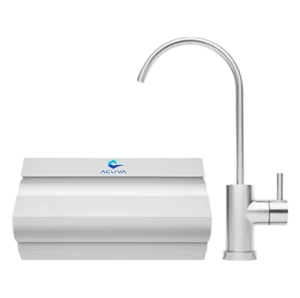
The Acuva Arrow 5 is a point-of-use UV-LED water purifier that may be used to clean water that is delivered to ice makers, drinking water faucets, kitchen faucets, and bathroom faucets.
This UV-LED system can produce purified drinking water at a rate of up to 1.3 gallons per minute without affecting water pressure. The unit can be purchased with either DC 12V or AC 120/240V power.
The Acuva Arrow’s extraordinarily extended lifespan is its main selling point. This UV filter can purify 900,000 litres of water over the course of up to ten years of operation. The Acuva Arrow is a fantastic option to take into consideration if you’re looking for a UV purifier that requires almost no maintenance.
The UV purifier chamber is constructed of stainless steel, while the body casing is built of high-quality aluminium, giving the device a sturdy, long-lasting design. The Acuva Arrow 5 comes with mounting tools, plumbing supplies, and power supplies for installation (DC or AC).
The Acuva Arrow also comes with a superior sediment pre-filter that lowers heavy metals and chlorine, but you may also use this purifier with any pre-filter of your own.
Pros
- Uses power on-demand hence consumes far less power.
- Long lifespan of 10 years
- Can be used with various applications in your home
- Comes with an installation kit and sediment pre-filter which lasts for 5,000 gallons
Cons
- Expensive
- Only the pre-filter is certified for performance
US Water Systems Pulsar UV Disinfection System
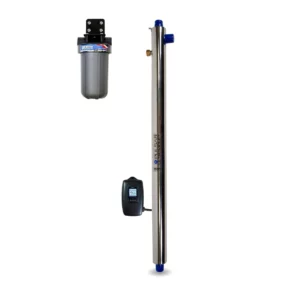
The US Water Systems Pulsar UV Disinfection System is one of the most recent UV disinfection systems to enter the market. Microorganisms are quickly rendered inactive by this whole-home application, making them unable to reproduce or infect people.
The Pulsar is built to deliver a dependable and steady UV output over the course of its 9,000-hour lifespan. On the full-color LED panel that is included, you may locate the data you require to assess the system’s performance.
Sediment in water can interfere with the UV process because it prevents UV light from reaching the water completely. Before water enters the system, the Pulsar has a 1-micron sediment pre-filter that gets rid of sand, salt, and dirt particles.
The Pulsar is simple to install and requires little care; all that needs to be done is change the UV lamp once a year, like most whole house UV water filters do (and you can do this without interrupting water flow).
As soon as the light has to be changed, the UV purification system will let you know, and if it doesn’t, an alert will go off.
Numerous characteristics help the Pulsar’s effectiveness and increase the safety of the UV disinfection procedure. The power source is enclosed in a sealed casing to prevent unintentional water damage, and the sturdy stainless steel chamber aids in preventing UV radiation deterioration.
Pros
- Lamp change notifications & alarm
- Comes with good safety features
- Made in the USA
Cons
- No certifications for disinfection performance
- Installation process might be complicated
Viqua VH410 Ultraviolet Disinfection System
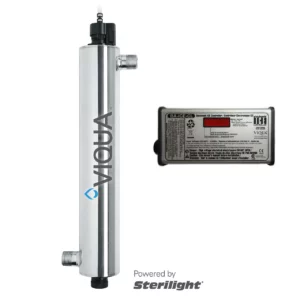
An effective UV water purifier with a flow rate of up to 18 GPM is the Viqua VH410. This UV water filter’s high UV output and compact design allow you to conserve space while getting comparable performance to a larger chamber.
Depending on your needs, you may install the Viqua VH410 either by itself or in conjunction with a water filter. Keep in mind that the VH410 won’t remove particles or chemicals from water, like as chlorine, which, while not harmful to your health in small doses, may nonetheless have an impact on the flavour or odour of your water.
It’s not necessary to employ a plumber to help you install the Viqua VH410. It is made to be easily assembled by the user, either vertically or horizontally (vertical is recommended). The lamp, the housing for the UV filter, and the wall-mounting bracket are all included in the box. To connect the Viqua system to your water line, you will need to purchase the fittings that are necessary.
The Viqua VH410 is the greatest UV water purifier for getting rid of bacteria and cysts like E. Coli, Salmonella, and Giardia. It may be used with both city and well water. It kills these germs and prevents them from reproducing by concentrating on their DNA. The VH410, which guarantees a constant high output, will continue to operate at its best for the duration of the lamp’s life.
You will need to swap out the light in the Viqua VH410 for a new one after about 9,000 hours of operation (or about a year). When it’s time to replace the lamp, the purifier’s built-in lamp change reminder will play a sound. There is also a digital countdown screen that you can use to monitor the device’s functioning and plan in advance to buy a replacement lamp.
There is very no more maintenance required besides changing the light. About every three months, you should clean scale and buildup from the lamp sleeve. The user handbook has instructions on how to accomplish this safely. You don’t need to take any action to increase flow rate because it will remain at up to 18 GPM for the duration of its life, depending on the inflow rate of water into your home. This guarantees that there will never be a decrease in water pressure in your faucets or showers.
Pros
- Viqua UV purifier systems have a durable design and can endure for more than ten years with proper maintenance.
- Simple to start up after installation
- Handy reminder for lamp replacement
Cons
- To connect the Viqua VH410 to your water line, you will need to acquire additional fittings.
- Installation may be too complicated for some.
Pelican Premium Ultra Violet (UV) Disinfection System
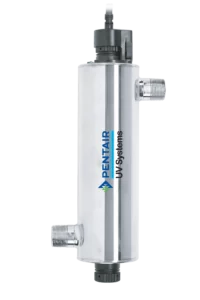
This cutting-edge UV filter system from Pelican, a reputable name in water filtration and purification, is another excellent alternative. Pelican’s UV disinfection system kills 99% of bacteria and virus-causing waterborne pathogenic organisms that cause sickness.
This eco-friendly system may be used in most residences thanks to its 9 to 16 GPM peak flow rate. The Pelican system won’t change the present flavour, odour, or appearance of the water in your home because it can only remove living bacteria from water.
The NSF 55 Class B accreditation sets the Pelican premium system different from other UV water filters. This accreditation provides reassurance that the system is made for additional water treatment to remove microorganisms and has passed third-party testing to be safe for human consumption.
The Pelican system is the best option if you want a simple UV purifier system. All that is required is that you replace your light once a year and make sure to clean the lamp sleeve every few months. Both of these procedures are quite easy to complete and only take a few minutes.
Finding a UV light that is safe to leave near small fingers may be crucial for families with young children. Young children cannot access the lamp or any of the other electrical parts of the Pelican premium UV disinfection system because of a safety cap, and the lamp has a specific plug that stops you from turning it on when it isn’t securely inside the UV chamber.
Last but not least, this UV purifier includes a sophisticated controller that informs you of the lamp’s condition and other useful data. This system’s availability in two sizes—one for small to medium-sized houses and one for larger households—is a useful feature.
Pros
- Comes with everything required for installation.
- Easy installation with written and video instructions.
- Suitable for families with young children.
Cons
- The fan can be noisy.
- Some reports on unit heating up the water that sits inside before it’s used.
Buyer’s Guide For The Top UV Water Purifiers
What is UV Radiation?
Between visible light and X-rays in the electromagnetic spectrum comes UV radiation, which is invisible electromagnetic energy. Up to 3 to 5 percent of the solar energy from the sun’s rays—or UV—is found in sunlight naturally.
UV radiation is divided into three subtypes: long-wave, medium-wave, and short-wave UV-A, UV-B, and UV-C, respectively. There are several advantages to UV filtration, even if excessive exposure to it may harm live tissue and raise our chance of developing skin cancer.
UV light is essential for the production of vitamin D and may be used to treat skin diseases like eczema. Due to its germicidal qualities, UV system is also used to disinfect water.
What is a UV Water Filter?
An efficient system for eliminating bacteria, viruses, cysts, and other live creatures that are occasionally found in drinking water is an UV filter, often known as a UV water purifier or a UV water steriliser.
Installed at the main water pipe at the point of entry into your home, this device has the appearance of a long, thin bulb.
Components of a UV Purification System
Four major components make up UV purifying systems.
- Reactor Chamber
The system’s reactor chamber is where the quartz sleeve and UV light are kept. The chamber also regulates the water flow through the apparatus. The reactor chamber is typically constructed of stainless steel, but some chambers may be made of different materials, such plastic.
- A UV lamp
UV-C radiation, which is known to be germicidal, is produced by the UV lamp. A mercury bead found in UV lamps is essential to the generation of UV-C light beams.
The mercury in UV lamps is heated by the filaments’ electrical current, which causes the mercury to vaporise in the UV lamp’s interior air space. The electrical arcs produced by the electrically arced mercury then produce UV-C with varying degrees of strength, which purifies water.
- Quartz Sleeve
The quartz sleeve is a glass tube that is long and cylindrical in shape. The sleeve prevents the UV lamp inside from coming into contact with the water. Through the tube, the lamp emits UV light that reaches the water. You must clean the sleeve every time the UV lamp is changed to prevent a decline in functionality since pollutants can cloud it.
- Controller Unit
The controller unit serves as the UV purifying system’s central nervous system. The device powers the UV lamp and regulates its electrical output to generate the UV-C radiation required to kill germs.
The complexity of controllers might vary depending on the needs of the system. Others feature additional components, such as lamp-change timers, low-UV alarms, and trouble signalling lights to notify the owners in the event of a system failure. Some are as basic as a cap fitting over the end of the lamp.
How do UV Water Purifiers Work?
By using a UV lamp to sterilise the hazardous microbes, UV water purifiers generate clean water, which includes eliminating microbiological pollutants, which can be harmful to your health, including bacteria, viruses, and protozoa.
The UV lamp in UV water purifiers generates UV rays with a wavelength that is ideal, typically 254nm (UV-C). These microbes’ outer cell membranes are penetrated by the UV radiation released, which then passes through the cell body and damages the DNA.
The intrinsic chemical links of the DNA are broken when UV-C light is absorbed, which changes the DNA and hinders reproduction. The bacteria thus loses its ability to reproduce and becomes sterile.
UV rays from UV water purifiers does not eradicate bacteria. By targeting their DNA, it renders them inactive and keeps them from reproducing to form colonies. These microbiological pollutants’ DNA is primarily designed for replication.
Waterborne diseases like cholera, typhoid, dysentery, and guinea worm sickness are caused by the ability of these dangerous active microorganisms to reproduce, multiply, and form colonies.
Disinfectants, however, can allow these dangerous germs to enter our bodies and pass through without doing any harm because they have rendered them inert.
There are two types of disinfectants: chemical and physical. UV radiation is a type of physical disinfectant that works well for disinfection because it doesn’t change the chemical makeup of water. Chlorine and other chemical disinfectants react with water to change its composition and affect its flavour and odour.
Advantages of Using a UV Filter
There are several benefits to using a UV water filter, whether your home gets its drinking water from the public water system or a private well. You can gain from utilising a UV purification system to cleanse your water by:
- Chemical-free disinfection
In contrast to other techniques, UV water purifiers don’t add chemicals to water or change its chemical makeup. Simply by passing a light across the water, it successfully destroys the hazardous bacteria.
- No added flavours or odors
You won’t taste or smell anything different in your water as a result of utilising UV water purifiers because nothing is added to it. Your water will continue to taste exactly the same.
- Virtually no maintenance
A major benefit of a UV filter is that it eliminates the need to frequently change multiple filters, which is required by a reverse osmosis system or a whole-home cartridge-based system. Simply clean the lamp case every few months, and replace the lamp about once every year.
- Safe drinking water
Having a UV water steriliser will ensure that, even if your city’s drinking water is compromised for any reason—you never know what the future may hold—you will still have access to water that is safe to drink.
Limitations of UV Water Purification Systems
Whole home UV water filters do, of course, have some limits, just like all other water filters and purifiers, such as:
- Does not remove contaminants
A UV water purifier is not what you need if you want to get rid of suspended particles in your water, especially toxins that alter the taste and odour of the water. Only living microbes can be killed by the system; pollutants in drinking water are unaffected.
- Requires power to work
You won’t be able to use your UV light if there is a power outage at your house because it runs on electricity.
- May heat up your water
It’s likely that the water under the UV lamp has warmed up if you haven’t switched on the faucet in some time. This can be fixed by turning on the faucet and letting the water go down the drain before cooler water comes.
UV Water Purifiers vs Water Filters
A water filter is not the same as a UV water purifier. A UV light is just a lengthy bulb enclosed in a metal casing, whereas a water filter is made out of a mesh cartridge, which is typically made of activated carbon or a similar material.
A filter and a UV purifier perform quite distinct functions. UV purifiers allow water to run directly through the UV tube without being slowed down by a filter, whereas water filters slow water down by trapping impurities in their medium to decrease or remove them.
As water enters your home through the incoming pipe, a UV lamp cures it. It eliminates dangerous bacteria, viruses, cysts, and other microbes in water by destroying their DNA. On the other hand, water filters cannot suffocate live things. By preventing the suspended particles from passing through the filter media, they merely remove them from the water.
When you should use a UV purifier
- For municipal water at home
UV purifier are put in place where water enters a house. There is no guarantee that the water in your home is fully sterile, even though the water in your neighbourhood has been treated to get rid of bacteria and other microbes before it gets there. This can only be guaranteed by a UV water filter used at home.
- When traveling
Bring a UV water purifier with you if you’re travelling or camping and don’t have access to a clean water source to make sure your water is safe to drink. You can use one of the several transportable, handheld water purifiers available for this purpose.
- For treating well water at home
While having a private well for your home has its advantages, you need be sure it is safe for consumption before allowing your family to begin drinking it. You can make sure that all of your home’s faucets and appliances are providing clean, safe water by installing a whole-house UV water filter system.
Key Considerations When Buying a UV Light Water Filter
Budget
The cost of each UV system varies. Some can be purchased for as little as $100, but more sophisticated systems may require a substantial upfront investment. While you don’t have to get the priciest model available to perform the task, keep in mind that cost and quality are frequently related.
UV Water Purification Needs
A UV water filter will undoubtedly be useful if your goal is to eliminate living pollutants from your water. Look elsewhere if you want to enhance the flavour of your water or get rid of pollutants like chlorine. A UV light won’t make things better for you.
Water Flow Rate
GPM, or gallons per minute, is the unit of flow measurement for all UV systems. This gauges the rate of water flow or the volume of water that can pass through the system at once. In addition to having a maximum flowrate capacity, UV purification devices may also have a minimum flowrate.
Very fast-moving water will probably move through the system with insufficient UV light exposure.
On the other side, water with a very low flow rate could cause the UV lamp to overheat and get damaged. There shouldn’t be an excessively high or low flow rate. Additionally, systems that use constant flow recirculation are preferable for UV purifier units.
In gallons per minute, flow rate for UV purifiers is calculated (GPM). This is the speed at which contaminated water can be properly cleansed while still moving through the system. 12GPM is the normal purification rate for water in a whole-house UV purification system.
Water Quality
The drinking water in your home may have some characteristics that make UV water purification system less effective. A UV purification system may not be able to effectively treat water if it contains a lot of iron, calcium, or magnesium, for example, or if it has a high sediment content.
Depending on the problems your water has, installing a water softener or whole-house filter before your UV light may help.
The amount of UV radiation that reaches the microorganisms is also decreased because some impurities absorb or scatter UV light, which affects how the rays travel through water.
These typical pollutants in surface water supplies include fulvic and humic acid, as well as iron and manganese. UV disinfection is therefore most effective when applied to water that has already been filtered to remove these pollutants.
The cover provided by soil, suspended particles, and other types of floating debris may also provide protection for microorganisms. Total Dissolved Solids (TDS) should be less than 0.3 ppm and water hardness should be less than 7 grains per gallon.
Space Availability
There are many different sizes of UV systems, and some demand more space than others. Small storage cabinets are unlikely to accommodate long lights, however it is simple to find a more compact UV lamp with the same GPM.
If the space you have available isn’t suitable for vertical installation, you should also think about whether a UV system can be put both vertically and horizontally or just vertically.
Wattage
The requisite UV-C, short-wave radiation must be produced by the ballast, which must be of a specific wattage. A 55 Watt, 120 Volt system is adequate for most homes.
Portable UV Purifier Units
A portable UV purifier device could be helpful in addition to water filters, which are the most typical outdoor purifying tool. Not all germs can be removed by portable water filters, however they are excellent in removing sediment and big bacteria.
All bacteria will be destroyed by UV radiation, but not sediment. When travelling outside, a portable UV device and filter like the SteriPen can be a terrific combination.
How To Choose The Right Size UV Unit?
There are many different sizes of UV water systems, so you might be unsure of how big of a system you need for your household. Everything from small, hand-held drinking systems to massive, whole-house systems that can move hundreds of gallons of water per minute is available.
Consider the following factors while choosing the right UV water purifier size for you:
Size of Your House
The greater GPM you require to effectively distribute purified water to every appliance in your house will depend on how big it is. Smaller homes, condos, or apartments should utilise 10 GPM systems, but larger residences with many bathrooms should use 15 GPM or higher systems.
Colour of Your Water
Your water’s colour can be a sign of excessive iron content or surface debris. It’s always recommended to assess if your water has a yellowish tint because this may prevent the UV rays from passing through the water properly.
Size of Your Plumbing
Even though the majority of UV systems are built to integrate effortlessly with your plumbing, it is still a good idea to research a product’s fittings before making a purchase. The flow of your water may be slowed down if you purchase a UV system that is incompatible with your plumbing.
Installation and Maintenance of a UV Purification system
Installing a UV purifier is quite complex, so you might opt to employ a plumber to take care of it for you. However, if you prefer doing things yourself and have up to an hour to spare, you may install a UV system yourself.
The installation instructions for your system will detail how to install your particular model, however if you’d want a general concept of how installation works, follow these steps:
1. Choose the location of the filter. If you’re installing a whole-house UV purifier, it probably won’t be by itself. If you use well water, the UV lamp could be used in addition to a whole-house water filter, a water softener, and a well pump.
In this instance, you just put your UV filter last so that water can pass through all of the other components you installed before it. Install your UV filter as close to the point where your water enters your property as you can if you don’t already have anything else in place.
2. Mount the lamp housing to the wall – The lamp housing for your UV lamp should be included. Using the provided mount, you may fasten this housing to the wall directly. If you decide to mount the lamp vertically, make sure to install it so that the power wires come out of the top; this helps to ensure the system can function properly.
3. Unscrew one of the lamp housing’s ends and slide your UV light inside. Use the O-rings that came with the lamp to close both ends.
Your UV lamp includes two threads: one for water to enter the system and one for water to exit the system and return to the water line. Connect your lamp to your water line using the appropriate threads. As directed by the manufacturer, connect them to your water line.
4. Turn on the water in your house – Next, turn on the water and use the appliances in your house to check for leaks.
5. Plug the UV system into the wall – The UV light must now be connected to your power by being plugged into your wall as the last step in the installation process. Make sure to connect the wire securely in accordance with your installation instructions; avoid letting the wires’ non-waterproof parts become damp.
UV water purifiers require maintenance, just like any other UV water treatment method. After 9,000 hours, or nearly every 12 months, the UV lamp itself needs to be replaced.
After 9,000 hours, the mercury in the lamp deteriorates, which lowers its efficacy, which is why you need to change the light. It only takes a few minutes to replace the light; all you need to do is remove the lamp housing from the wall, remove the old lamp, and replace it.
Frequently Asked Questions
How is the Strength of UV Measured?
Milli-joules per centimetre square, or mJ/cm2, are used to describe UV strength. According to the US Department of Health, an efficient UV purifier for drinking water applications needs to deliver at least 30,000 mJ/cm2.
Is a Whole House Filter Installed Before a UV Lamp Necessary?
If you only want to get rid of microorganisms and aren’t concerned about other toxins, installing a whole house water filter will help since it will remove the silt and other particles which could cause issues in a UV filter. However, it is not fully necessary.
What Will Happen if I Don’t Replace My UV Lamp?
Simply put, the UV light will stop working as well and won’t be as effective at killing the germs as it should be.
Is Water With UV Filters Safe?
It is safe to treat water with UV. It doesn’t employ dangerous chemicals or alter the water’s chemical makeup. By using UV-C light, it merely eliminates the presence of bacteria and viruses in your water source.
UV Purifier or UF Filter: Which Is Better?
If you want to get rid of bacteria and viruses, UV water purification is more effective. It sterilises your water by killing microbes with strong UV light.
Contrarily, a UF or ultrafiltration filter removes particles from your water by forcing water through a membrane with tiny holes, much like a normal osmosis water filter does. The fact that UF can also filter out silt and other particles is the one benefit it has over UV.
